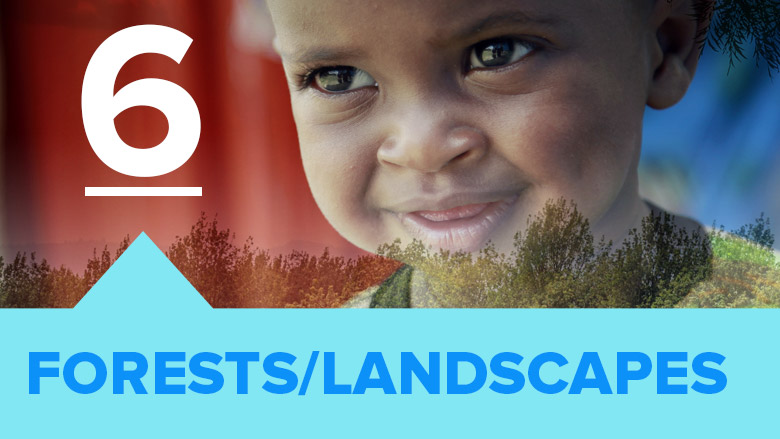Challenge and Opportunity
Forest landscapes are an essential part of development and climate change action, contributing to the livelihoods of 1.3 billion people as well as the health of our planet. But forests are under threat. The demand to use land for agriculture drives deforestation. Transportation, energy infrastructure, mining and wood-based energy, also affect forest cover.
More than 100 countries have recognized the need for stronger forest protection and have included actions related to land-use change and forests in their Nationally Determined Contributions (NDCs) for carbon emission reductions. Forests are nature’s own carbon sink and if protected and managed well, can increase the resilience of rural landscapes.
The land use sector, including forests, is critical to achieving climate targets. Enhanced efforts to preserve forests and restore degraded lands can help address an expected global gap in emission reductions needed to keep the global temperature increase under 2 degrees C.
Trees growing in crop fields help to reduce soil erosion, and can serve as sources of fertilizer, while reducing water and heat stress affecting crops. Trees can also increase households’ food security by providing food and fodder when crops become unavailable, and increase people’s coping capacity by providing assets that can be harvested in times of need.
The World Bank’s Forest Carbon Partnership Facility, BioCarbon Fund Initiative for Sustainable Forest Landscapes (ISFL) and Forest Investment Program work with more than 50 tropical forested countries building sustainable landscape programs. These funds build on a decade of experience and have provided a wealth of knowledge on how to quantify emission reductions from different land-use activities and have helped pave the way for other large-scale, land-use carbon initiatives.
Private sector commitment around deforestation-free commodity supply chains is critical to conserving forest resources and reducing risks for businesses that rely on commodity supplies. Through the International Finance Corporation (IFC), the World Bank Group encourages responsible corporate investments across the forest products supply chain and works to create a more level playing field for legitimate forest-sector enterprises that adopt sustainable practices.
Transformative Action
In Ethiopia, land that was long considered to be too dry and infertile to invest in, now attracts attention and investment from smallholder farmers. Working at the intersection of water and land management, land rights and land use since 2008, the World Bank’s Sustainable Land Management Program, financed by the Global Environment Facility (GEF), has led to more resilience and income for Ethiopia’s farmers. The government of Ethiopia, working with the World Bank and other partners, implemented the national program—more than $150 million overall—investing in land use plans, in terracing the land and land certification, all of which have helped revive local economies. In Ethiopia’s Tigray region, the Sustainable Land Management II Project for example, financed by the GEF and implemented by the World Bank was designed to reduce land degradation and improve land productivity in 135 watersheds. The project’s objectives were pursued by providing capital investments, technical assistance and capacity building to smallholder farmers in the targeted watersheds, and to national and sub-national government institutions.
In 2017, the government of Ethiopia and the World Bank signed an $18 million grant to support the Oromia Forested Landscape Program. Implemented in a region the size of Norway, the program is part of the World Bank’s BioCarbon Fund Initiative for Sustainable Forest Landscapes.
Working closely with the IFC, the Initiative for Sustainable Forest Landscapes partnered with Nespresso, providing a $3 million grant to the Nespresso Sustainability Innovation Fund to provide farmers in Ethiopia’s Oromia region with intensive, field-based agronomy and business training to advance sustainable coffee production. IFC also provided a $3 million loan to Nespresso to increase shade tree planting within coffee farms and enhance the sustainability of wet mill processing.
This first-of-its-kind collaboration is based on shared goals of ensuring a ‘greener’ approach to planting and processing, higher productivity for farmers, and making the coffee industry in Ethiopia more resilient to climate change. The successful partnership can serve as a model for scaling up similar activities in other countries that focus on other commodities.
Similarly, IFC has also helped leverage institutional financing for the forestry sector by issuing a first-of-its-kind Forests Bond in 2016. The Bond raised over $152 million from major institutional investors to support Wildlife Works’ Kasigau Corridor REDD Project in Kenya, which allows rural farmers to benefit from conserving local forest resources and protecting the Kasigau wildlife migration corridor, while providing employment opportunities for women and other community benefits.
Expected Results
By 2020 more than 1 million hectares of land will be sustainably managed across Ethiopia and more than 15,000 landless youth will receive land-rights certificates. About 9,000 hectares will be reforested in the Oromia Region and 25,000 people will directly benefit from the new Oromia project.
Over the 3-year project, the initiative in Ethiopia with Nespresso aims to train 20,000 farmers and register 77 coffee processing wet mills, and assist 9,540 hectares of traditional coffee production on upgraded standards under the Nespresso AAA Sustainable Quality Program™. After one year in operation the public-private joint effort is on target to reach its goals. Over 17,000 farmers, 34 percent of whom are women, have been trained on sustainable coffee production practices.
Key Facts & Figures
- Forest degradation and land-use change contribute about 12 percent of the world’s greenhouse gas emissions.
- Although the pace of global deforestation has slowed since the 1990s, it remains high with about 13 million hectares (gross) lost each year. This is partially offset by reforestation, making the total annual net forest cover loss 5.6 million hectares—an area larger than Costa Rica.
- Over the last five years, the World Bank committed $1.3 billion to forest-related work.
